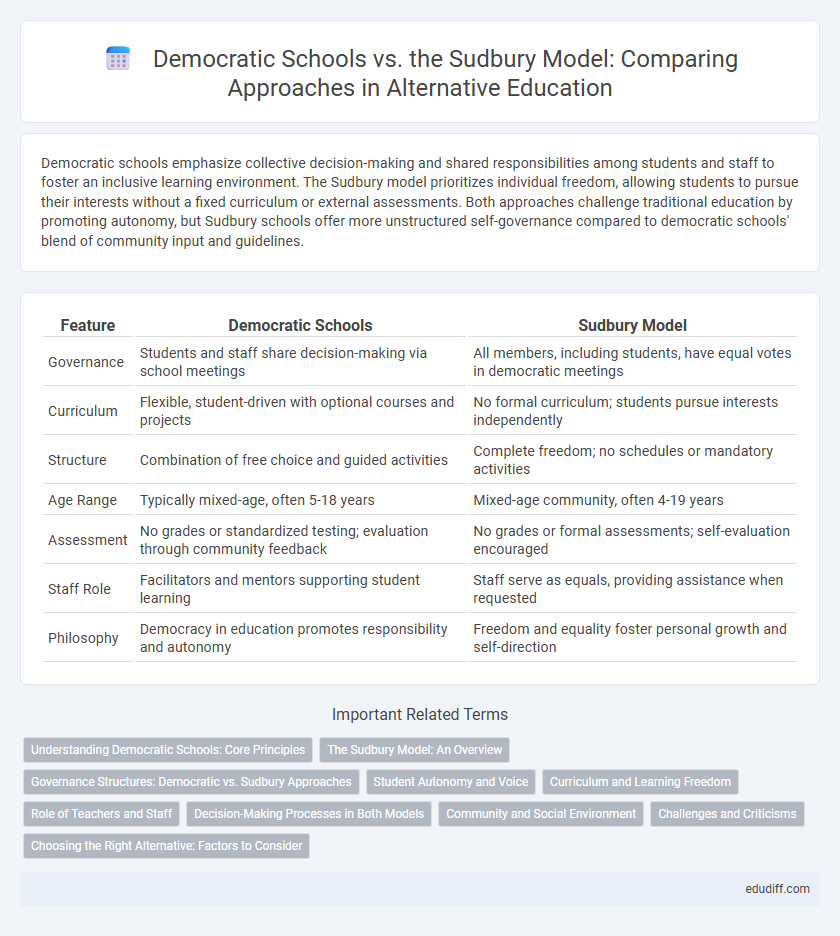Democratic schools emphasize collective decision-making and shared responsibilities among students and staff to foster an inclusive learning environment. The Sudbury model prioritizes individual freedom, allowing students to pursue their interests without a fixed curriculum or external assessments. Both approaches challenge traditional education by promoting autonomy, but Sudbury schools offer more unstructured self-governance compared to democratic schools' blend of community input and guidelines.
Table of Comparison
| Feature | Democratic Schools | Sudbury Model |
|---|---|---|
| Governance | Students and staff share decision-making via school meetings | All members, including students, have equal votes in democratic meetings |
| Curriculum | Flexible, student-driven with optional courses and projects | No formal curriculum; students pursue interests independently |
| Structure | Combination of free choice and guided activities | Complete freedom; no schedules or mandatory activities |
| Age Range | Typically mixed-age, often 5-18 years | Mixed-age community, often 4-19 years |
| Assessment | No grades or standardized testing; evaluation through community feedback | No grades or formal assessments; self-evaluation encouraged |
| Staff Role | Facilitators and mentors supporting student learning | Staff serve as equals, providing assistance when requested |
| Philosophy | Democracy in education promotes responsibility and autonomy | Freedom and equality foster personal growth and self-direction |
Understanding Democratic Schools: Core Principles
Democratic schools emphasize student agency, equal participation in decision-making, and community governance, fostering an environment where learners co-create rules and curriculum. Core principles include respect for individual voice, intrinsic motivation, and collaborative problem-solving, supporting holistic personal development. This model contrasts with Sudbury schools by prioritizing structured democratic processes and shared accountability within the school community.
The Sudbury Model: An Overview
The Sudbury Model emphasizes democratic governance where students have equal say in decision-making processes, allowing complete freedom to explore their interests without a fixed curriculum. This model contrasts with traditional democratic schools by prioritizing self-directed learning and personal responsibility over structured educational frameworks. Sudbury schools create environments that foster creativity, critical thinking, and collaboration through peer interactions and real-world experiences.
Governance Structures: Democratic vs. Sudbury Approaches
Democratic schools emphasize shared governance where students and staff collaboratively create rules and participate in decision-making, fostering a community-oriented environment. The Sudbury model adopts a direct democracy approach, granting equal voting rights to all members regardless of age, with a School Meeting responsible for all administrative decisions. This structure enables a fluid, self-regulated system that prioritizes individual autonomy within a collectively managed framework.
Student Autonomy and Voice
Democratic schools emphasize shared decision-making, allowing students to actively participate in governance and shape their educational experience, fostering collective responsibility. The Sudbury model prioritizes complete student autonomy where learners have full freedom to choose their activities without predetermined curricula, reflecting a deep trust in intrinsic motivation. Both models center student voice but differ in structure: democratic schools balance collaboration with guidance, while Sudbury schools grant radical independence.
Curriculum and Learning Freedom
Democratic schools emphasize a structured curriculum that balances student choice with guided learning objectives, fostering both individual interests and communal responsibilities. The Sudbury model prioritizes absolute learning freedom, allowing students to direct their education entirely based on personal curiosity without predefined curricula or academic assessments. This fundamental difference shapes distinct educational experiences: democratic schools integrate democratic governance with curricular frameworks, while Sudbury schools operate on self-directed learning within a fully democratic community environment.
Role of Teachers and Staff
In democratic schools, teachers actively facilitate learning by guiding discussions and supporting curriculum development, fostering a collaborative environment where student voices influence educational choices. Sudbury model schools minimize traditional teacher roles, emphasizing student autonomy with staff serving as resource providers and administrators rather than instructors. This distinction highlights the democratic school's balance between structure and freedom, contrasting with Sudbury's pure emphasis on self-directed learning and minimal adult intervention.
Decision-Making Processes in Both Models
Democratic schools emphasize collective decision-making through teacher and student councils, fostering inclusivity and shared responsibility in governance. The Sudbury model grants each student and staff member equal voting power in meetings, ensuring direct participation in all policy and operational decisions. Both models prioritize participatory democracy, but the Sudbury approach uniquely eliminates hierarchical roles, promoting complete equality in decision-making processes.
Community and Social Environment
Democratic schools emphasize collaborative decision-making where students and staff share equal voices, fostering a community based on collective responsibility and mutual respect. The Sudbury model centers on radical individual freedom within a participatory community, allowing students to shape their social environment through self-governance and cooperative interaction. Both frameworks cultivate strong social bonds by empowering learners to engage actively in a supportive, democratic community.
Challenges and Criticisms
Democratic schools often face challenges related to balancing student autonomy with academic standards, leading to critiques about inconsistent educational outcomes and potential gaps in core knowledge. The Sudbury model is criticized for its lack of structured curriculum, which opponents argue may hinder students' preparedness for conventional higher education or workforce demands. Both models confront skepticism regarding their ability to adequately equip students with essential skills in highly competitive academic and professional environments.
Choosing the Right Alternative: Factors to Consider
When choosing the right alternative education model, consider the level of student autonomy, governance structure, and community involvement. Democratic schools typically blend guided learning with collective decision-making, while Sudbury models emphasize complete student freedom and self-directed learning. Evaluating how each aligns with the child's personality, learning style, and family values is essential for making an informed choice.
Democratic Schools vs Sudbury Model Infographic

 edudiff.com
edudiff.com